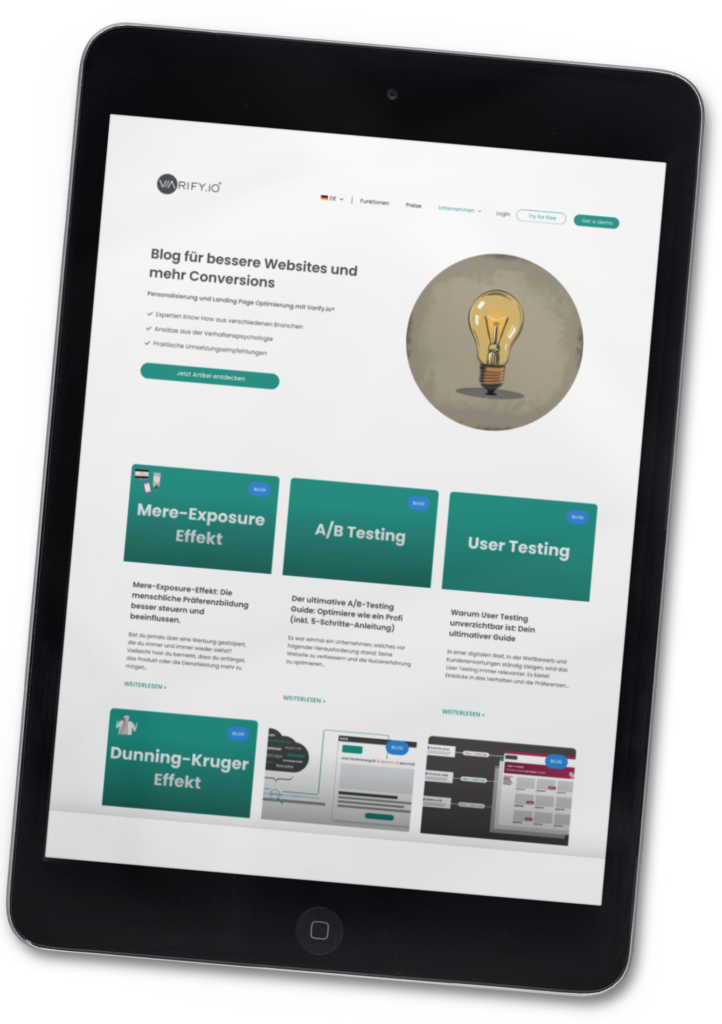In the digital landscape, it's not enough to just drive traffic to your website. It's about converting that traffic into tangible results: Conversions.
Let's take a detailed look at the art and science of conversion optimization.
Table of contents
What is Conversion Optimization?
Conversion optimization, often referred to as conversion rate optimization (CRO), is a systematic, data-driven process. The goal is to improve the performance of a website, landing page, or online store in such a way that the probability increases that visitors will perform a desired action.
This action can be many - a purchase, subscribing to a newsletter, or filling out a contact form. But why is it so important? In a sea of online offers, it's no longer enough to just have an online presence. The competition is just a click away, and users have become more demanding.
Therefore, every click, every visitor must count. Conversion optimization ensures that resources and budgets are used wisely and reflected in real results.
Definition Conversion and Conversion Rate
In the context of the digital world, "conversion" and "conversion rate" are two terms that every marketer should know and understand.
Conversion
A conversion is the successful completion of a desired action by a website visitor. A simple example is the purchase of a product in an online store, but filling out a form or watching a video can also be counted as a conversion.
Conversion Rate
This is a percentage that represents the ratio of conversions to the total number of website visitors. For example, if out of 100 visitors 5 buy a product, then the conversion rate is 5%.
Steps to successful conversion optimization
Conversion optimization is a dynamic interplay of different steps. Each of these steps is important to improve user interaction with a website or app and ultimately achieve the desired endpoint - be it a purchase, sign-up, or download. From careful analysis to implementation to final evaluation and playout, here's a detailed look at the entire conversion optimization process.
1st analysis:
Before you start the actual optimization, you need to understand where and why visitors bounce. This is where web analytics tools come into play. By collecting data - for example on visitor flows, dwell times or bounce rates - you can identify weaknesses and potentials of your website.
2nd planning:
With the data obtained, the next step is planning. Which elements should be revised? What hypotheses can be made? And how can success be measured? Here it is determined which measures are to be implemented and in what order.
3. conception:
The concrete conception begins on the basis of the planning. Here, the previously identified weak points are worked on and solution approaches are developed. The aim is to develop concrete design and content proposals, which are visualized in the next step.
4th design:
The conceptual ideas are visualized in this step. Be it through wireframes, mock-ups or prototypes - this is where the future look and functionality of the optimized elements are defined. It is crucial that the proposed design changes are both appealing and functional to increase conversion rates.
5. implementation:
Before making extensive changes to a website or an app, one should first conduct A/B tests. This means creating two versions: the current version (A) and a new version with the proposed changes (B). Tools like Optimizely or Google Optimize enable such tests. Users are randomly assigned to one of the two variants. This allows you to find out which version performs better before making full-scale adjustments.The technical implementation of the planned changes is next. Here, developers and designers work hand in hand to ensure that everything runs smoothly and the user experience is optimized.
6. evaluation:
After the A/B test has collected a sufficient amount of data, it is evaluated. This involves analyzing which of the two variants has a higher conversion rate or other relevant KPIs. It is important to ensure that the results are statistically significant in order not to draw false conclusions due to coincidences.
7th playout:
If a new variant has proven to be superior in the A/B test, it is played out for all users. The old version is replaced and the optimizations are fully implemented. However, it is essential to continue to monitor performance and retest and adjust as needed, as user behavior and external factors can change over time.
Conversion optimization methods and measures
The conversion rate of a website or online store depends on a variety of factors. To effectively increase the conversion rate, there are various approaches and methods that target specific aspects of the online presence.
Each method has its own strengths and should be used depending on the specific objective and the identified weaknesses. Some of the most important conversion optimization methods are presented below:
Purchase process optimization (shopping cart optimization)
One of the main reasons customers abandon an online purchase is a complicated or opaque checkout process. With shopping cart optimization, you focus on making the payment process as simple and smooth as possible. This can be achieved by simplifying forms, clearly stating shipping costs, or even offering different payment options.
Usability optimization
The usability of a website has a direct influence on the conversion rate. Intuitive navigation, clear call-to-action elements, and fast loading time are just some of the key factors. A user-friendly design not only increases visitor satisfaction, but also their willingness to perform a desired action.
Content optimization
Content plays a critical role in retaining and converting visitors. High-quality, relevant content that addresses the needs and questions of your target audience can increase dwell time and boost conversion. It's not just about text, but also images, videos and other interactive elements.
Mobile optimization
With the constant increase of mobile users, it is essential that your website or online store is optimized for mobile devices. The design must be responsive, i.e. adapt to different screen sizes, and the loading times should be kept as short as possible.
Conversion optimization in SEO
Search engine optimization (SEO) and conversion optimization go hand in hand. A high rank in search results attracts more visitors, but what good is traffic if visitors don't convert? The point here is to drive organic visitors specifically to content or products that are relevant to them.
Conversion optimization in SEA
Search engine advertising (SEA) can help you attract targeted traffic to your site. By optimizing ad copy, landing pages, and bidding strategies, you can not only get more clicks, but also a higher conversion rate.
Important tools and resources for the CRO
For successful conversion rate optimization, it is essential to have the right tools. Suitable tools not only help to collect extensive data and evaluate it, but they can also perform A/B tests, create heat maps or take a closer look at the user experience (UX). Proven web analytics tools include Google Analytics or Matomo, for example, which provide insights into the behavior of website visitors.
For performing A/B tests, varify.io is the ideal solution. For a detailed overview of click behavior and scroll depth, heatmap tools like Hotjar or Crazy Egg are almost indispensable. If you also want direct feedback from visitors, survey tools such as SurveyMonkey or Typeform offer corresponding functions. The targeted use of these tools can thus make a decisive contribution to effectively implementing and checking optimization measures.
Common conversion optimization mistakes
There are also some stumbling blocks lurking in conversion optimization. The most common mistakes include:
Jumping to conclusions: Terminating A/B tests prematurely and drawing hasty conclusions.
Too many changes at the same time: If too many elements are changed at once, it is complicated to determine the exact impact of each change.
Neglect of mobile usersMobile users have specific requirements and should not be overlooked.
Decide not based on data: It is risky to base decisions on mere assumptions rather than concrete data.
One-time optimization tests: Conversion optimization should be understood as a continuous process, not a one-time action.
By knowing and avoiding these potential mistakes, you can greatly increase the success of your conversion optimization efforts.
Conclusion
Conversion optimization is an ongoing endeavor that should always be based on user needs and behavior. Through a methodical approach, the right set of tools, and continuous monitoring and adjustment, you can ensure that your website or online store achieves the best possible results. At the same time, you should always remain open to new things and be ready to adapt to changing conditions.

